Guides
How It’s Made Toilet Paper
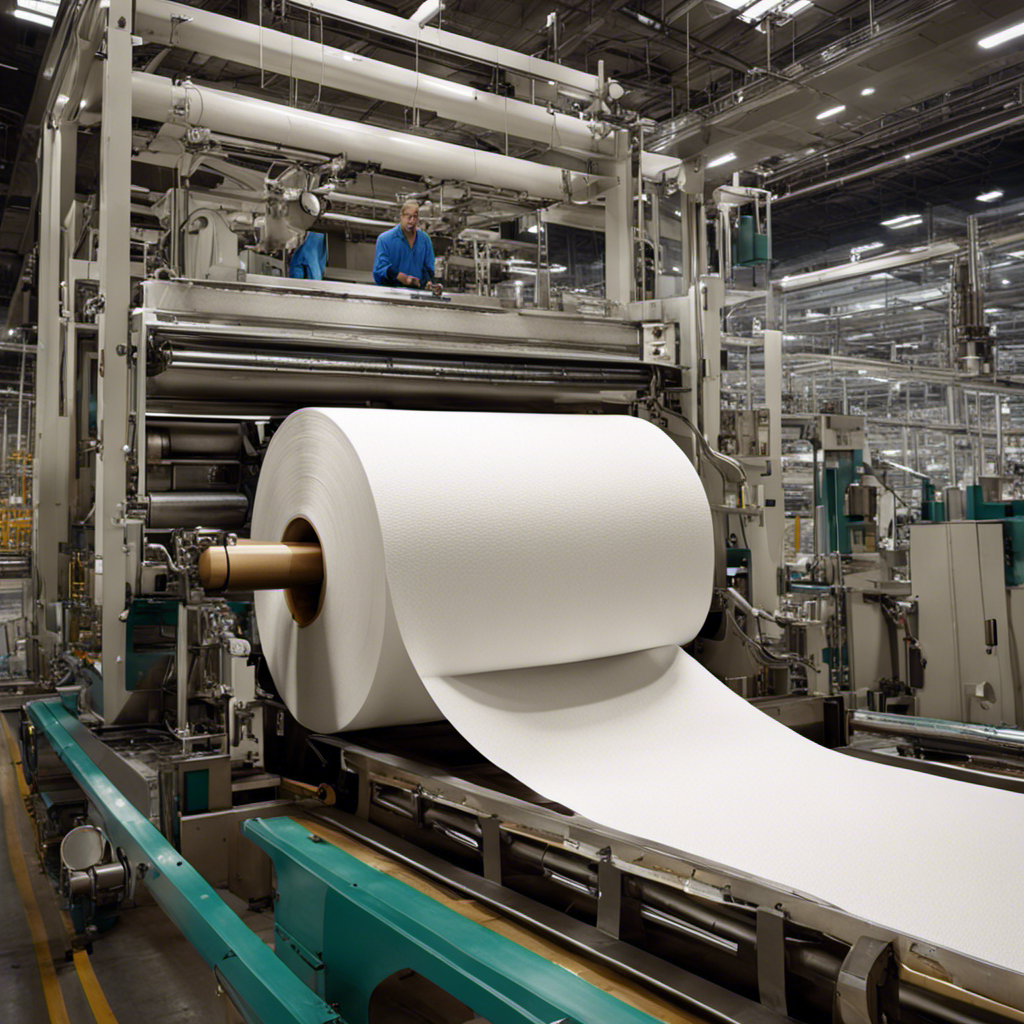
As a manufacturing analyst, I am constantly fascinated by the intricate processes behind everyday products. One such item that we often take for granted is toilet paper.
In this article, we will delve into the fascinating world of toilet paper production, exploring the history, raw materials used, and the intricate steps involved in creating this essential product.
From the paper making process to the packaging and distribution, we will leave no roll unturned in our quest to understand how it’s made.
Key Takeaways
- Toilet paper is made from wood pulp and recycled paper, which are mixed with water to form a slurry and pressed into paper web.
- The paper making process involves breaking down raw materials into a fibrous mixture, feeding it into large paper machines, and drying it to remove moisture.
- Quality control measures are in place to ensure uniformity, consistency, thickness, texture, and durability of the toilet paper.
- The industry is actively researching and developing sustainable methods and materials for toilet paper production, including the use of recycled fibers and alternative fibers like bamboo and hemp.
The History of Toilet Paper Production
The history of toilet paper production dates back to ancient China. It is fascinating to see how this essential product has evolved over time.
In ancient China, toilet paper was made from the bark of mulberry trees. The bark was soaked, boiled, and then beaten into a pulp. This pulp was then spread out and pressed into thin sheets, which were left to dry in the sun. The process was labor-intensive and time-consuming.
However, as time went on, the production methods became more efficient and advanced. Today, toilet paper is made using a combination of wood pulp and recycled paper. It is processed through a series of steps, including pulping, bleaching, pressing, and drying. These advancements in production techniques have allowed for the mass production of toilet paper, making it readily available to people worldwide.
Now let’s delve into the raw materials used in toilet paper manufacturing.
Raw Materials Used in Toilet Paper Manufacturing
You can’t produce toilet paper without using raw materials like wood pulp or recycled paper. In the manufacturing process, raw material sourcing plays a crucial role.
For wood pulp, trees are harvested from sustainably managed forests. The logs are then debarked and chipped into small pieces. These chips are chemically treated to remove impurities and break down the wood fibers. The resulting pulp is bleached to achieve the desired whiteness.
Recycled paper, on the other hand, goes through a deinking process to remove ink and other contaminants.
Both raw materials are then mixed with water to form a slurry. This slurry is then pressed and dried on large rotating drums to remove excess water and create the paper web.
The environmental impact of raw material sourcing is a concern, but the industry is taking steps to ensure sustainable practices are followed, such as responsible forestry and increased use of recycled paper.
The Paper Making Process
Start by gathering all the necessary raw materials for the paper making process.
The first step in manufacturing toilet paper is preparing the pulp. This involves breaking down the raw materials, such as wood chips or recycled paper, into a fibrous mixture.
Once the pulp is ready, it is fed into large paper machines. These machines have screens and rollers that help remove excess water and create a continuous sheet of paper.
The paper then goes through a drying process, where it is heated and passed through heated rollers to remove any remaining moisture. This ensures that the paper is strong and ready for further processing.
The drying process is crucial in maintaining the quality and integrity of the toilet paper.
How Toilet Paper Is Cut and Shaped
When it comes to the cutting techniques used in the production of toilet paper, precision is key. The rolls are carefully cut to ensure uniformity and consistency in size.
The shaping process involves shaping the rolls into the familiar cylindrical shape, with attention paid to the edges for a smooth finish.
Quality control measures are implemented throughout the process to ensure that each roll meets the highest standards. Checks for thickness, texture, and overall durability are conducted.
Cutting Techniques Used
One common cutting technique used in the production of toilet paper is rotary cutting. This method involves using a rotating blade to cut large rolls of paper into smaller, individual rolls. It is a highly efficient and precise technique that ensures consistent sizing and shape of the toilet paper rolls.
To evoke emotion in the audience, let’s consider the following sub-lists:
-
Benefits of rotary cutting:
-
Uniformity: The rotary cutting technique ensures that each roll of toilet paper is the same size and shape, providing a consistent experience for consumers.
-
Efficiency: By using rotary cutting, manufacturers can quickly cut large rolls into smaller ones, allowing for increased production rates and meeting high demands.
-
Challenges of rotary cutting:
-
Blade maintenance: The blades used in rotary cutting need to be regularly sharpened and replaced to maintain their effectiveness and prevent any damage to the paper.
-
Initial investment: Implementing rotary cutting in the production process requires significant investment in specialized machinery, which may pose a financial challenge for some manufacturers.
Overall, rotary cutting is an effective method for achieving precise and efficient roll formation in toilet paper production.
Shaping Process Explained
To shape the rolls, you’ll need to stack and compress the cut sheets of paper using a specialized machine. This process is crucial in creating the final product with the desired shape and thickness.
The sheets of paper are stacked on top of each other, forming a tall pile. The machine then applies pressure to compress the stack, making it more compact. This compression helps to eliminate any air gaps and ensures uniformity in the roll’s shape and size.
The challenge in this shaping technique lies in maintaining consistent pressure throughout the stack to avoid any variations in thickness. Manufacturing challenges include the proper alignment of the sheets and the control of compression force to achieve the desired result.
Quality Control Measures
After the shaping process is completed, the next step in manufacturing toilet paper is the implementation of quality control measures. As a manufacturing analyst, ensuring the highest standards of quality is of utmost importance to me. To achieve this, we conduct rigorous quality inspections and product testing throughout the production process.
Here are some key aspects of our quality control measures:
-
Quality Inspection:
-
Visual inspection for any visible defects or imperfections.
-
Measurement checks to ensure the correct dimensions and thickness of the toilet paper.
-
Product Testing:
-
Strength and durability tests to ensure the toilet paper can withstand regular usage.
-
Absorbency tests to guarantee effective performance.
By implementing these quality control measures, we can ensure that every roll of toilet paper that leaves our manufacturing facility meets the highest standards of quality. This attention to detail ensures customer satisfaction and trust in our brand.
Now, let’s move on to the next step: adding fragrances and colors to toilet paper.
Adding Fragrances and Colors to Toilet Paper
When it comes to adding fragrances and colors to toilet paper, two key points to consider are the effectiveness and safety of the fragrances used, as well as consumer preferences for colors.
As a manufacturing analyst, it is important to ensure that the fragrances used are not only pleasant but also effective in neutralizing odors.
Additionally, understanding consumer preferences for colors can help guide decisions on which colors to incorporate into toilet paper designs, ensuring that it appeals to a wide range of consumers.
Fragrance Effectiveness and Safety
The fragrance used in toilet paper can greatly impact its effectiveness and safety. When it comes to fragrance safety, it is important to consider the potential risks of using scented toilet paper. Fragrances can cause allergic reactions in some individuals, leading to skin irritation or respiratory issues.
Therefore, it is crucial to choose fragrance-free options for those with fragrance allergies or sensitivities. On the other hand, for those who enjoy scented toilet paper, it is essential to ensure that the fragrance used is safe and non-irritating. Manufacturers should carefully select fragrances that are hypoallergenic and undergo rigorous testing to ensure they meet safety standards.
By prioritizing fragrance safety, we can enhance the overall experience of using toilet paper without compromising on the well-being of consumers.
Speaking of consumer preferences, let’s now delve into the topic of color choices for toilet paper.
Consumer Preferences for Colors?
After examining the effectiveness and safety of fragrances in toilet paper, it is important to consider consumer preferences for colors. When it comes to toilet paper, consumers have varied preferences regarding the color of the product. While some individuals may prefer traditional white toilet paper, others may opt for colored options to add a touch of personalization to their bathrooms. As a manufacturing analyst, it is crucial to understand these consumer preferences and incorporate them into the production process. However, it is equally important to consider the environmental impact of using dyes or pigments to color toilet paper. Balancing consumer preferences with sustainable manufacturing practices is key in meeting the demands of the market while minimizing the ecological footprint. By taking these factors into account, we can ensure that the production of colored toilet paper meets both consumer expectations and environmental standards.
Transitioning into the subsequent section about packaging and distribution of toilet paper, it is essential to address the ways in which these products are packaged and delivered to consumers.
Packaging and Distribution of Toilet Paper
Toilet paper is typically packaged and distributed in large rolls for convenience. The packaging innovations in the toilet paper industry have come a long way to meet the changing needs of consumers. Companies are now focusing on sustainability efforts by using eco-friendly materials for packaging.
Here are two sub-lists that will evoke emotion in the audience:
-
Benefits of packaging innovations:
- Easy to use and store
- Keeps the toilet paper clean and hygienic
-
Importance of sustainability efforts:
- Reduces environmental impact
- Supports responsible consumption and production
The manufacturing process of toilet paper involves precise steps and measurements. It starts with cutting large rolls into smaller ones, followed by perforating and embossing the paper. The paper is then wound onto a core and packaged using sustainable materials.
These packaging innovations and sustainability efforts are just the beginning of the industry’s commitment to improving the manufacturing process. As we move forward, there are even more exciting innovations and future trends in toilet paper manufacturing to explore.
Innovations and Future Trends in Toilet Paper Manufacturing
As we continue exploring the manufacturing process of toilet paper, it is important to address the growing concern for toilet paper sustainability and the demand for eco-friendly alternatives. Many consumers are now seeking options that are not only soft and absorbent but also environmentally friendly.
In response to this need, manufacturers are actively researching and developing innovative methods and materials for toilet paper production. One such trend is the use of recycled fibers in the manufacturing process. By utilizing recycled paper, manufacturers can reduce the reliance on virgin wood pulp and minimize deforestation.
Additionally, there is a rising interest in the use of alternative fibers such as bamboo and hemp, which are known for their fast-growing nature and minimal environmental impact. These eco-friendly alternatives offer the potential to further reduce the ecological footprint of toilet paper production.
Overall, the industry is committed to finding sustainable solutions that balance the demand for toilet paper with environmental concerns. By embracing these innovations and future trends, we can contribute to a more environmentally conscious approach to toilet paper manufacturing.
Frequently Asked Questions
What Are the Different Types of Toilet Paper Available in the Market?
There are various types of toilet paper available in the market, including scented and luxury options. They offer different features and qualities to cater to individual preferences and needs.
How Is Toilet Paper Tested for Quality and Durability?
In toilet paper manufacturing, quality and durability are tested through a series of strength tests. These tests measure factors like tensile strength, tear resistance, and absorbency to ensure that the toilet paper meets industry standards and customer expectations.
Are There Any Environmental Concerns Associated With Toilet Paper Production?
Toilet paper production raises concerns about water pollution and energy consumption. It’s essential to address these environmental issues by implementing sustainable practices, such as using recycled materials and reducing water usage during the manufacturing process.
Can Toilet Paper Production Cause Deforestation?
Toilet paper production can cause deforestation, impacting wildlife. The demand for wood pulp, a key ingredient in toilet paper, leads to the destruction of forests. This can disrupt ecosystems and harm species that rely on these habitats.
Is Recycled Toilet Paper as Effective as Regular Toilet Paper?
Recycled toilet paper is just as effective as regular toilet paper. While the manufacturing process may differ, both options provide the same functionality. It’s important to consider the environmental impact of toilet paper production and choose sustainable options.
Conclusion
In conclusion, the manufacturing process of toilet paper is a finely tuned symphony of raw materials, intricate machinery, and precise measurements.
From the history of its production to the packaging and distribution, every step is carefully orchestrated to ensure a seamless experience for the consumer.
Innovations in fragrance and color have added a touch of artistry to this essential product.
As a manufacturing analyst, I am amazed by the attention to detail and the dedication of the industry in providing a high-quality product.
The future holds exciting possibilities for further advancements in toilet paper manufacturing.
Mateo’s flair for writing is matched only by his keen eye for design. As an interior designer turned writer, Mateo brings a unique perspective. He blends aesthetics with functionality in every piece he pens, providing readers with beautifully crafted content that’s also supremely useful.
Mateo loves exploring the latest bathroom tech trends and is our expert on smart toilets. When he’s not writing or designing, Mateo can be found sketching ideas for his next big project at local coffee shops.
Guides
Eco-Friendly Materials in Smart Toilet Manufacturing
Amid growing environmental concerns, discover how eco-friendly materials in smart toilet manufacturing can transform your bathroom and benefit the planet.

Eco-friendly materials are essential in crafting smart toilets, considerably reducing environmental impact. You'll find recycled porcelain and bamboo as primary choices, both minimizing reliance on virgin resources. Stainless steel adds durability and recyclability, ensuring a longer lifespan. Additionally, biodegradable plastics, derived from plants like cornstarch, lessen landfill waste and reduce carbon footprints. These materials don't just conserve resources; they also promote better hygiene and enhance indoor air quality. By embracing these sustainable options, you'll contribute to a healthier planet, making your bathroom eco-friendlier than ever. Learn how these innovations are shaping the future of smart toilets.
Key Takeaways
- Eco-friendly materials like recycled porcelain and bamboo reduce environmental impact and support a circular economy in smart toilet manufacturing.
- Stainless steel offers durability and recyclability, promoting sustainability and lowering overall carbon footprints.
- Biodegradable plastics made from plant-based materials significantly reduce landfill contributions and greenhouse gas emissions during production.
- Low-flow technology and dual-flush systems in smart toilets enhance water conservation, saving thousands of gallons annually.
- Antimicrobial materials improve hygiene and indoor air quality, contributing to healthier living environments in eco-friendly toilet designs.
Importance of Eco-Friendly Materials
In today's world, the importance of eco-friendly materials in smart toilets can't be overstated. By opting for sustainable materials, you help reduce the environmental footprint associated with traditional toilet manufacturing. Eco-friendly materials like recycled porcelain and bamboo minimize the need for virgin resources and energy-intensive processes, making your choice a responsible one.
Additionally, many health-focused lifestyle blogs highlight the benefits of using eco-friendly products in daily life, encouraging consumers to make informed choices that align with their values, such as diverse content on nutrition.
Choosing a sustainable toilet made from stainless steel not only enhances durability but also guarantees recyclability at the end of its life cycle, promoting a circular economy. High-quality plastic alternatives made from plant-based materials, such as cornstarch, are biodegradable. This means they contribute less to landfills, making them appealing to eco-conscious consumers.
Moreover, incorporating these eco-friendly materials into smart toilet designs supports significant water conservation efforts. Many of these materials work in tandem with water-efficient technologies, helping to reduce overall water usage.
As consumer demand for environmentally responsible products rises, manufacturers that prioritize eco-friendly materials can enhance their brand reputation and foster customer loyalty. Embracing these materials isn't just a trend; it's a step towards a more sustainable future for all.
Types of Sustainable Materials

When it comes to choosing sustainable materials for smart toilets, several options stand out for their eco-friendliness and functionality. One popular choice is recycled porcelain, which not only reduces waste but also contributes to the circular economy by using reclaimed materials. This helps lower the carbon footprint associated with new production processes.
Additionally, incorporating materials that are both functional and sustainable, like butter's nutritional benefits, can inspire innovative designs that prioritize health and environmental consciousness.
Another excellent option is bamboo toilet seats. Bamboo is a highly renewable resource, known for its durability and moisture resistance, making it an ideal material for bathroom fixtures. Plus, its sustainable harvesting practices make it an environmentally friendly choice.
Stainless steel is also favored in smart toilet manufacturing. Its long-lasting and corrosion-resistant properties guarantee that it remains functional for years and is fully recyclable at the end of its lifespan.
Additionally, some smart toilets feature biodegradable materials, such as high-quality plastics derived from cornstarch. These materials promote sustainable solutions while minimizing environmental impact.
Lastly, incorporating antimicrobial materials enhances hygiene by inhibiting bacterial growth, improving indoor air quality, and guaranteeing a healthier bathroom environment.
Benefits of Recycled Porcelain
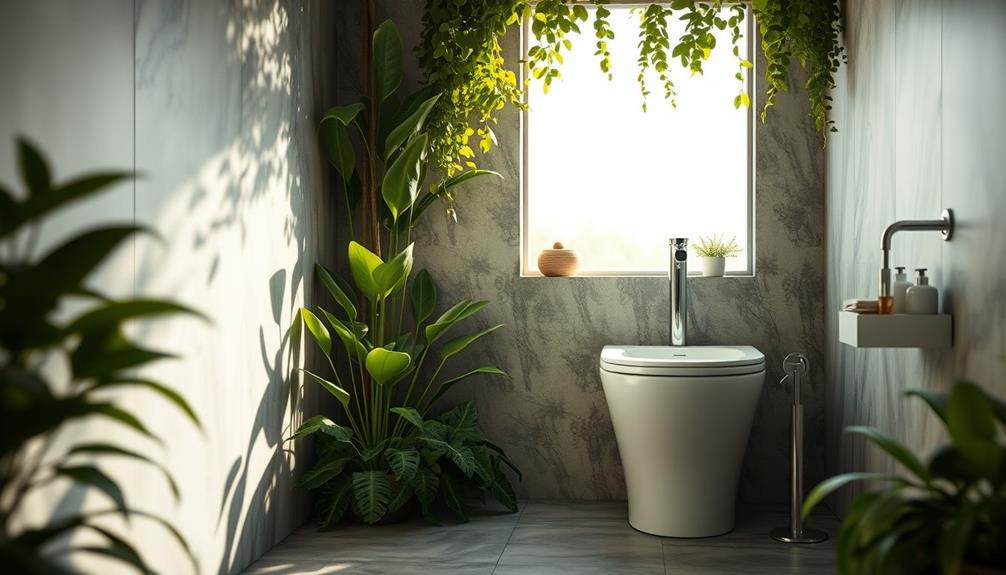
Recycled porcelain stands out as a top choice in the domain of eco-friendly materials for smart toilets due to its impressive environmental benefits. By utilizing reclaimed materials, recycled porcelain helps reduce waste and supports a circular economy in smart toilet manufacturing. This means that less material ends up in landfills, making it an environmentally friendly option.
Additionally, incorporating recycled materials can enhance a company's portfolio diversification by aligning with sustainable practices.
Moreover, using recycled porcelain considerably lowers the carbon footprint associated with production. It requires less energy and fewer virgin materials compared to traditional porcelain, which is essential in today's sustainability-focused market.
The durability of recycled porcelain also guarantees that your smart toilet maintains high performance and aesthetic appeal over time, reducing the need for frequent replacements.
Incorporating recycled porcelain allows manufacturers to meet sustainability certifications, enhancing their market competitiveness. This appeals to eco-conscious consumers who prioritize sustainable materials in their purchasing decisions.
Additionally, the use of recycled porcelain minimizes the extraction of natural resources, promoting responsible sourcing practices.
Advantages of Bamboo Seats

Bamboo seats offer a remarkable eco-friendly alternative to traditional toilet seat materials. When you choose a bamboo seat, you're opting for a sustainable resource that grows quickly and can be harvested without harming the plant. This means that the environmental impact is considerably lower than that of seats made from non-renewable materials.
Additionally, adopting eco-friendly materials can also contribute to overall wellness, similar to how a holistic lifestyle approach enhances well-being in various aspects of health.
Moreover, bamboo is naturally resistant to moisture and mold, which makes these seats durable and long-lasting compared to conventional plastic or wood options. You'll appreciate how they stand up to daily use while maintaining their aesthetic appeal.
With their stylish, natural look, bamboo seats can easily complement various bathroom designs, adding a touch of elegance while being eco-conscious.
Additionally, the production of bamboo toilet seats generally has a lower carbon footprint, supporting a circular economy that prioritizes sustainability. By utilizing bamboo, you also help reduce waste and promote responsible harvesting practices.
Plus, bamboo's efficient growth means it requires less water usage compared to traditional hardwoods, making it a smarter choice for both your home and the planet.
Embracing bamboo seats not only enhances your bathroom but also aligns with your eco-friendly values.
Stainless Steel and Its Impact
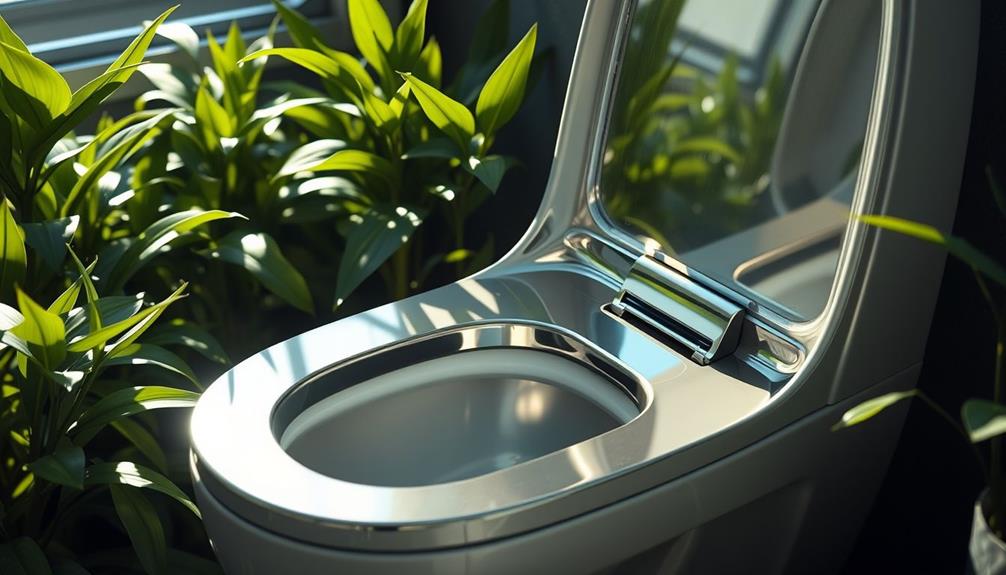
Stainless steel toilets are a game-changer for eco-conscious homeowners seeking durability and style.
These toilets boast a remarkable lifespan, thanks to their high corrosion resistance, which means you won't have to worry about frequent replacements.
When you choose stainless steel, you're also making a significant contribution to reducing the environmental impact of toilet manufacturing.
Additionally, proper toilet maintenance, such as regular inspections and cleaning, can further enhance the longevity of these eco-friendly fixtures, leading to a more sustainable bathroom environment.
Regular cleaning prevents buildup and clogs, ensuring peak performance over time.
Here's why stainless steel is the smart choice for your bathroom:
- High recycled content: This material requires less energy to produce, lowering its carbon footprint.
- Fully recyclable: At the end of their life cycle, stainless steel toilets can be completely recycled, promoting a circular economy.
- Antimicrobial properties: These toilets help inhibit bacterial growth, enhancing hygiene in your bathroom.
- Sleek aesthetic: Stainless steel adds a modern touch to your bathroom design, elevating its overall look.
- Sustainable alternative: Compared to traditional materials, stainless steel provides a robust and eco-friendly option.
Innovations in Plastic Alternatives

You might be surprised to learn about the advancements in biodegradable plastics, especially those made from plant-based materials like cornstarch.
These innovations not only cut down on landfill waste but also offer a more sustainable alternative for smart toilets.
Additionally, the use of vegan alternatives in materials emphasizes a commitment to environmentally friendly practices.
As you consider your options, think about how these eco-friendly materials can enhance both functionality and environmental responsibility.
Biodegradable Plastic Innovations
Driving innovation in sustainable design, biodegradable plastics are transforming the landscape of smart toilets. Made from plant-based materials like cornstarch, these biodegradable alternatives break down naturally within months to years, greatly reducing long-term environmental impact compared to traditional petroleum-based plastics.
This change not only minimizes landfill contributions but also promotes a circular economy. Additionally, the push for eco-friendly manufacturing processes parallels the growing interest in renewable energy sources, such as geothermal energy, which further emphasizes sustainability in modern construction practices.
Recent advances in biodegradable plastic formulations have improved their durability and moisture resistance, making them ideal for smart toilet manufacturing without sacrificing functionality. You can feel good knowing that these eco-friendly toilets utilize materials that lower carbon footprints by up to 30% compared to conventional plastic production processes.
Here are some key benefits of biodegradable plastics in smart toilets:
- Break down naturally, reducing landfill waste.
- Lower long-term environmental impact.
- Improved durability for practical use.
- Appeal to eco-conscious consumers seeking sustainable options.
- Support a circular economy by promoting recycling and reuse.
Plant-Based Material Benefits
Building on the advancements in biodegradable plastics, plant-based materials are gaining traction as innovative alternatives in smart toilet manufacturing. Derived from sources like cornstarch, these materials are biodegradable and can greatly reduce contributions to landfills compared to traditional petroleum-based plastics. They decompose in industrial composting facilities within 90 to 180 days, promoting a circular economy and minimizing environmental impact.
| Benefit | Description |
|---|---|
| Biodegradable | Decomposes in composting facilities within 90-180 days. |
| Reduced Greenhouse Gas Emissions | Emits up to 70% less greenhouse gas during production. |
| Comparable Durability | Matches the durability and functionality of traditional materials. |
| Appeals to Eco-Conscious Buyers | Aligns with consumer demand for sustainable products. |
Water Conservation Strategies

When you adopt low-flow technology in your bathroom, you're not just saving water; you could cut your usage by up to 60%.
Dual-flush systems let you choose the right flush for the job, helping you save even more.
Plus, consider waterless urinals, which can conserve a staggering amount of water each year while reducing your environmental footprint.
Low-Flow Technology Adoption
Low-flow technology is revolutionizing water conservation strategies in modern bathrooms. By adopting low-flow toilets, you can reduce water consumption to 1.28 gallons per flush or less, which cuts your water use by at least 50% compared to traditional models.
This not only helps you conserve water but also contributes to a more sustainable bathroom environment. Additionally, implementing eco-friendly materials in your bathroom fixtures can further enhance sustainability efforts.
Consider these benefits of low-flow technology:
- Save approximately 13,000 gallons of water annually.
- Potentially cut over $140 from your water bills each year.
- Use water-efficient fixtures that meet EPA WaterSense standards.
- Enjoy improved energy efficiency while maintaining performance.
- Reduce your household carbon footprint.
Dual-Flush System Benefits
Integrating a dual-flush system into your bathroom can amplify the water-saving benefits of low-flow technology. With dual-flush toilets, you get two flush options: a lower volume flush for liquid waste (typically 0.8 gallons) and a full flush for solid waste (typically 1.6 gallons). This design effectively helps you reduce water consumption while maintaining performance.
By implementing strategies to optimize your water usage, you can enhance your eco-friendly initiatives and improve overall household efficiency, aligning with keyword optimization and content strategy.
By switching to dual-flush toilets, you can lower your household's toilet water usage by about 20-60%. For an average family of four, this translates to saving between 15,000 to 20,000 gallons of water each year. Not only does this lead to reduced water bills, but it also greatly lessens your environmental impact.
Moreover, using a dual-flush system encourages mindful water usage, allowing you to choose the appropriate flush based on waste type. This promotes conservation habits that align perfectly with an eco-friendly bathroom ethos.
Many modern dual-flush models even enhance your bathroom's aesthetics, proving that you don't have to sacrifice style for sustainability. Overall, adopting this technology lets you save money while making a positive difference for the planet.
Waterless Urinal Efficiency
Waterless urinals consistently prove to be an efficient solution for water conservation in both commercial and residential settings. By using these innovative fixtures, you can save at least 56,800 liters of water annually per unit, markedly reducing overall water consumption.
Unlike traditional urinals, waterless models utilize a biodegradable sealant that traps odors without requiring any flushing water. This makes them an environmentally friendly choice, especially beneficial in regions where water is scarce. Additionally, adopting such sustainable fixtures can support broader environmental goals, as seen in initiatives promoting efficient water use.
By installing waterless urinals, you not only adopt sustainable bathroom practices but also enjoy considerable savings on your water bills. They align perfectly with broader water conservation strategies, such as the EPA's WaterSense program, promoting efficient water use.
Here are some key benefits of waterless urinals:
- Marked water savings of up to 56,800 liters annually
- No need for flushing, reducing water consumption
- Biodegradable sealant eliminates odors effectively
- Cost-effective solution for both businesses and homeowners
- Supports environmentally friendly practices in your bathroom
Switching to waterless urinals is a smart move for anyone looking to make a positive impact on our environment while saving money.
Health and Environmental Considerations

When considering health and environmental impacts, eco-friendly materials in smart toilets play a crucial role. By using recycled porcelain and bamboo, manufacturers not only cut down on carbon footprints but also enhance indoor air quality, minimizing harmful substances during production. This choice leads to healthier living spaces for you and your family.
Stainless steel is another excellent material, offering durability and corrosion resistance while being fully recyclable, thereby supporting a circular economy.
Additionally, high-quality plastic alternatives made from plant-based materials biodegrade, helping reduce landfill waste and your exposure to harmful chemicals from traditional plastics.
Moreover, incorporating antimicrobial properties into these materials effectively inhibits bacterial growth, promoting better hygiene and health in your bathroom environment.
A lifecycle assessment of these eco-friendly materials shows a significant reduction in resource depletion and environmental impact, aligning with sustainable development goals.
This commitment to sustainability not only benefits your health but also guarantees a cleaner planet for future generations.
Future Trends in Smart Toilets

As smart toilets evolve, you'll notice an impressive shift towards sustainability and user-centric design. Future trends in smart toilets are set to revolutionize your bathroom experience while promoting eco-friendly practices.
Manufacturers are increasingly using sustainable materials like recycled porcelain and bamboo, greatly reducing environmental impact.
You can expect advanced water-saving technologies that save households around 13,000 gallons of water annually, making a notable contribution to water conservation efforts. Plus, future smart toilets will offer enhanced customization options, allowing you to adjust water temperature and pressure to suit your preferences.
Here are some exciting trends to look out for:
- Sensors that optimize water usage based on individual needs.
- Integration of smart technology that enhances performance without sacrificing eco-friendliness.
- User-friendly interfaces for easier control and customization.
- Expanded use of sustainable materials in manufacturing processes.
- Increased market growth, projected at a CAGR of 10.5% from 2020 to 2027.
These innovations not only make your bathroom smarter but also align with your values for sustainability and resource efficiency.
Frequently Asked Questions
Are Smart Toilets Eco-Friendly?
Yes, smart toilets are eco-friendly. They feature water-efficient technologies and advanced flushing systems that greatly reduce water usage. Plus, many models incorporate energy-saving features, promoting a sustainable bathroom experience while enhancing your comfort.
What Is Eco-Friendly Toilet Paper Made Of?
Eco-friendly toilet paper's made from recycled paper, bamboo, or agricultural residues like wheat straw. These materials reduce deforestation and waste, while biodegradable processes guarantee no harmful chemicals pollute the environment during production.
Is There an Eco-Friendly Alternative to Toilet Paper?
Yes, there are eco-friendly alternatives to toilet paper. You can use bidets, reusable cloth wipes, or bamboo toilet paper. These options reduce waste, save trees, and offer sustainable solutions for your bathroom needs.
How Are Toilets Eco-Friendly?
Toilets are eco-friendly because they use water-efficient fixtures, like low-flow systems, reducing water waste. Many also incorporate sustainable designs and materials, promoting better hygiene while minimizing environmental impact through innovative waste management solutions.
Conclusion
Incorporating eco-friendly materials in smart toilet manufacturing isn't just a trend; it's a necessity. Did you know that using recycled porcelain can reduce energy consumption by up to 30%? By choosing sustainable options like bamboo seats and stainless steel, you're not only enhancing your bathroom's efficiency but also contributing to a healthier planet. As innovations continue to emerge, the future of smart toilets looks promising, blending technology with environmental responsibility. Let's embrace these changes for a greener tomorrow!
With an impeccable eye for detail and a passion for bathroom-related, Ava leads our editorial team gracefully and precisely.
Under her guidance, Best Modern Toilet has flourished as the go-to resource for modern bathroom enthusiasts. In her free time, you might find Ava exploring antique shops and looking for vintage bathroom fixtures to add to her collection.
Guides
The Debate Over Smart Toilet Data Collection: Privacy Vs. Health Benefits
Learn how smart toilets weigh the benefits of health monitoring against the potential risks of privacy invasion, raising critical questions about our digital future.
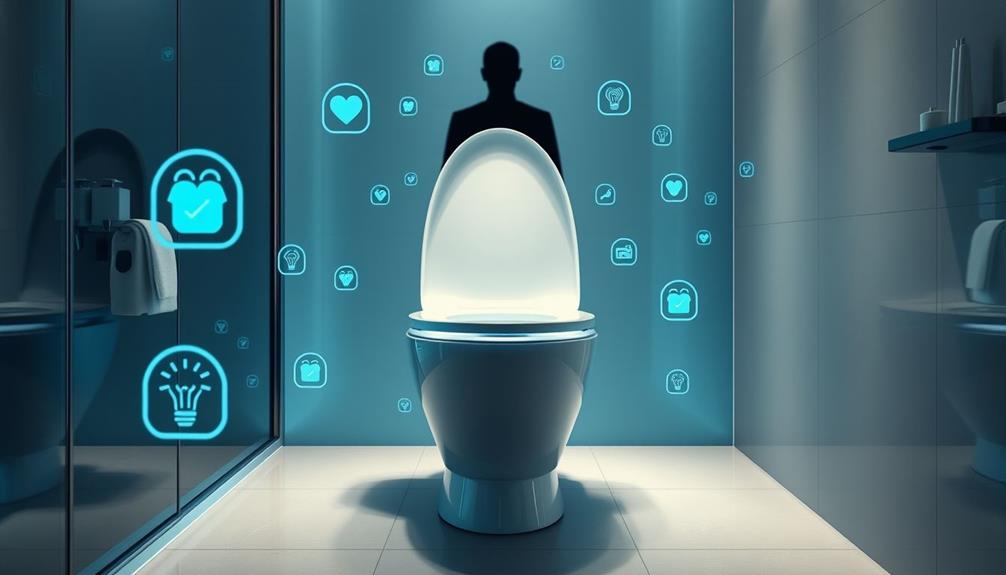
Smart toilets offer a blend of health benefits and privacy concerns. By collecting detailed health data, these devices can detect over 600 health conditions, promoting proactive health management. However, the collection of sensitive information raises serious privacy risks. Hacking could expose personal data, and current security measures often fall short. Users might hesitate to share their data due to concerns about misuse and consent. Balancing these factors is essential for acceptance. So, if you want to explore how smart toilets navigate these complex issues, there's more to uncover about the ongoing discussions in this evolving field.
Key Takeaways
- Smart toilets offer significant health benefits by detecting over 600 conditions, promoting proactive health management and timely interventions.
- Privacy concerns arise from sensitive data collection, with risks of hacking and inadequate consent mechanisms potentially compromising user information.
- Existing privacy laws may not adequately protect user data or keep pace with technological advancements, raising ethical issues surrounding data sharing.
- User willingness to share data increases with clear communication about health benefits and robust privacy protections, fostering trust in the technology.
- Effective integration into daily routines relies on user comfort and control over personal data, balancing convenience with privacy concerns.
Smart Toilet Technology Overview
Smart toilets represent a groundbreaking advancement in health technology, merging everyday bathroom fixtures with sophisticated sensor systems. These smart toilets are equipped with advanced sensor technologies that analyze waste data, providing you with vital health insights. By monitoring aspects like urine flow and waste texture, they can help detect diseases such as cancer and infections, allowing for early intervention.
Additionally, understanding toilet mechanics and the importance of proper waste disposal can contribute to overall health, making smart toilets an even more valuable addition to modern bathrooms, especially as toilet types and efficiency continue to evolve.
Using biomarker technology, smart toilets can also track various health indicators. They can identify the presence of blood in urine and gather metabolic health information tied to your nutrition and lifestyle. Research at Stanford Medicine has propelled this technology, aiming to enhance early disease detection through real-time monitoring.
Moreover, smart toilets connect to secure cloud storage, enabling the safe transmission of health data. This capability raises important discussions around data privacy and user consent, ensuring that your health information remains protected.
The potential integration of smart toilet technology into public health applications could facilitate large-scale health monitoring, tracking infectious disease outbreaks, and improving urban living through smart city initiatives. As you consider the benefits, it's important to weigh the implications of this innovative technology on your health and privacy.
Health Benefits of Data Collection
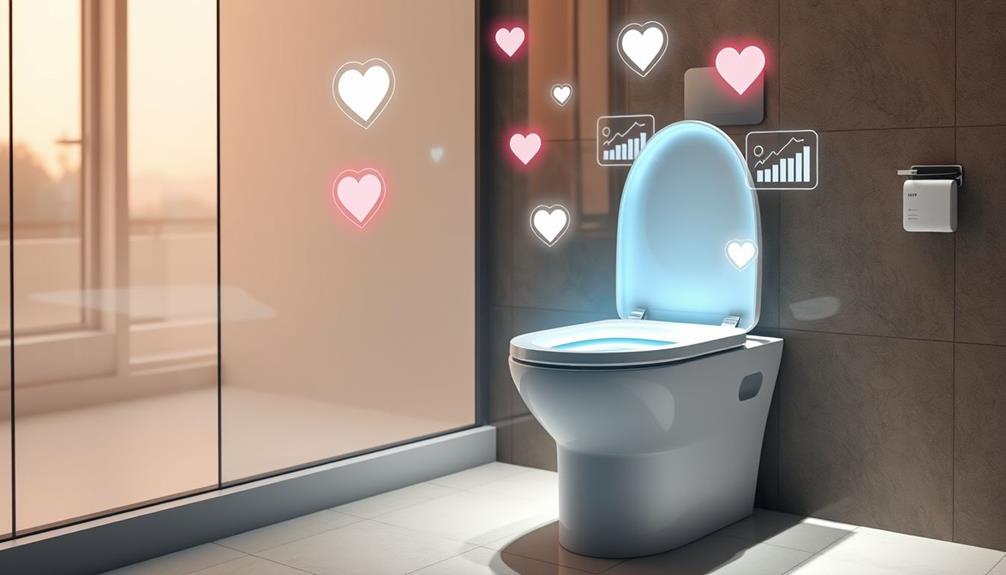
By leveraging advanced data collection capabilities, smart toilets offer significant health benefits that can transform how you monitor your well-being. These innovative devices can analyze urine to detect over 600 human conditions, including serious illnesses like cancer and diabetes, by monitoring metabolites linked to your health and lifestyle.
Regular use of smart toilets can lead to improved awareness about health indicators, promoting proactive health management and encouraging healthier lifestyle choices. Additionally, incorporating insights from the importance and benefits of play can help foster overall well-being in children and adults alike.
Frequent urine monitoring through smart toilets provides real-time health insights, allowing you to make timely interventions based on your individual health data. Imagine having access to non-invasive testing for various biomarkers through the integration of smart toilets with portable mass spectrometry technology. This could enhance the accessibility of health monitoring in your everyday life.
Moreover, smart toilet data collection can improve public health outcomes by identifying trends in disease outbreaks, such as COVID-19, through large-scale, anonymized data analysis. For the aging population, utilizing smart toilets for health monitoring may also enhance medication adherence tracking, providing insights into drug metabolism and overall health management.
With these benefits, smart toilets can empower you to take control of your health and foster a proactive approach to well-being.
Privacy Concerns and Risks

As you consider using a smart toilet, think about the sensitive health data it collects and the potential privacy risks involved.
These devices can be vulnerable to hacking, which might expose your personal information to unauthorized users.
Furthermore, similar to how emails remain vulnerable to hacking, smart toilets may not have robust security measures in place.
Additionally, the current consent mechanisms may not protect you adequately, raising concerns about how your data could be shared or misused.
Data Collection Concerns
Concerns about data collection in smart toilets revolve around the sensitive health information they gather, such as urine and waste analysis. You might worry about how this data could be misused or exposed. With personal health data being collected, privacy concerns escalate, especially considering the potential for unauthorized access.
| Concern | Description | Implication |
|---|---|---|
| Sensitive Data | Smart toilet seats collect detailed health metrics. | Increased risk of privacy breaches. |
| Data Security Measures | Without proper security, hackers can access your data. | Potential exposure of personal info. |
| Consent Mechanisms | Ethical debates on consent types can affect privacy. | User autonomy may be compromised. |
| Legal Protections | Privacy laws exist but may not keep up with technology. | Questions about effectiveness remain. |
It's essential to understand that the information gathered is subject to privacy standards similar to those for healthcare providers. However, the effectiveness of these safeguards in an evolving tech landscape raises significant questions. As you consider smart toilet technology, weigh the health benefits against these data collection concerns to make an informed decision.
Security Vulnerabilities Analysis
Smart toilets, while innovative, come with serious security vulnerabilities that can compromise your privacy. These devices collect sensitive health data, including biomarker information, which can be a treasure trove for hackers if not properly secured.
Security experts warn that unauthorized access to smart toilet systems could expose your personal health information, akin to breaches seen in traditional healthcare environments. Additionally, the collection of health data by smart devices raises concerns about diversification of retirement portfolio and how it parallels safeguarding our personal information, emphasizing the need for robust security measures.
Data gathered by these toilets is subject to the same privacy standards as that from healthcare providers, making stringent data protection measures essential. The ongoing debate about consent mechanisms is critical; you should understand whether you're giving blanket or active consent for your information to be collected. Without clear guidelines, your privacy could be at risk.
Moreover, the ethical implications of health data misuse are concerning. There's potential for law enforcement to access this information, raising alarms about the erosion of your privacy rights.
As smart toilets become more common, it's crucial to scrutinize how data is collected, stored, and shared. Ensuring your privacy is protected should be a priority as you consider the benefits these devices offer.
User Experience Insights

As you explore the user experience of smart toilets, you'll notice that installation can be straightforward but may come with some design challenges.
The data collected by smart toilets can enhance personalized experiences, yet many users are also hesitant about sharing their data, which influences how they integrate this technology into their daily routines.
Balancing convenience and privacy will be key to enhancing your overall experience with smart toilet technology, especially considering the ethical considerations in educational data mining.
Installation Experiences and Challenges
Many users found the installation of smart toilet seats to be relatively straightforward, yet several encountered challenges that stemmed from design flaws and compatibility issues with their existing hygiene practices.
While the initial setup might seem easy, you may face complications during the dismantling process of your old toilet seat, which can disrupt your overall experience. Additionally, having the right tools and essential items for a home cleaning kit can greatly facilitate the cleaning and maintenance of your new smart toilet setup.
Clear installation instructions and support are essential to address these user concerns effectively. Without them, you might feel frustrated, especially if you run into unexpected issues that hinder your convenience.
The shift to a smart bathroom can be exciting, but your comfort level with integrating the smart toilet into your daily routine plays a significant role in how satisfied you're with the experience.
Some participants reported feeling hesitant about adopting this new technology, which could impact their long-term use of smart toilets.
To enhance user acceptance and satisfaction, manufacturers need to focus on improving installation processes and ensuring compatibility with various bathroom setups. By addressing these challenges, you're more likely to enjoy the benefits of smart toilet technology in your home.
Data Sharing Willingness
Data sharing willingness among users of smart toilets reveals a complex landscape of preferences and concerns. You might find that your comfort level hinges on several key factors. Many users express a strong desire for ownership and control over their personal data, which is often a deal-breaker when it comes to sharing.
For instance, similar to users of air purifiers, concerns about health benefits and privacy frequently intersect. Here are three emotional drivers that shape your willingness to share:
- Health Benefits: If sharing your usage data could lead to improved health insights, you might be more inclined to consent.
- Privacy Protection: You likely want assurances that your sensitive information is secure and confidential, which can greatly affect your trust.
- Control Options: Knowing you can opt-out or manage your data preferences gives you a sense of empowerment, making you more open to sharing.
Clear communication about the purpose of data collection also plays a vital role. When you're informed about how your data will be used and the specific benefits it may bring, your data sharing willingness increases.
Ultimately, balancing health benefits with privacy concerns is key to steering through this new technology.
Integration Into Daily Routines
Integrating a smart toilet seat into your daily routine can greatly enhance your hygiene practices, but its success hinges on how seamlessly it fits into your established habits. If the smart toilet aligns with your daily behaviors, you're more likely to embrace its benefits.
Ease of installation plays an essential role here; you want a product that doesn't complicate your routine. Additionally, understanding the importance of mental health support can encourage users to seek out technology that positively impacts their well-being.
Participants in studies emphasized that while they appreciated the health information provided by smart toilets, they wanted a non-intrusive experience. If using the toilet feels too different from what you're used to, you might resist the technology. Ownership and control over your personal data also factor into your willingness to integrate this innovation. When you know your health information is secure, you're more inclined to accept the change.
Ultimately, the key to successful integration lies in enhancing your established habits rather than disrupting them. If the smart toilet can provide tangible health benefits while fitting seamlessly into your routine, you're likely to see it as a valuable addition to your daily life.
Participant Demographics and Exclusions
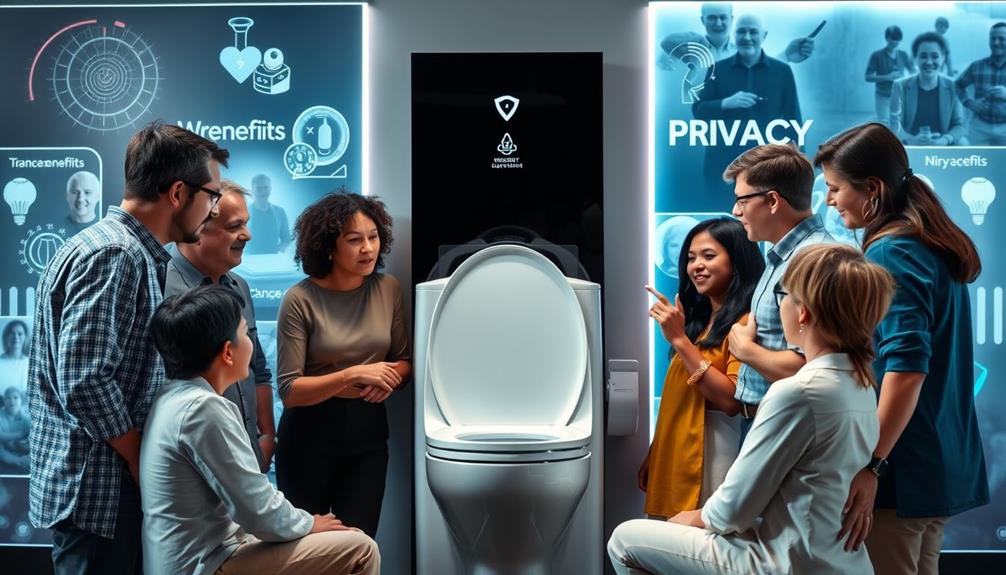
The study included 31 participants from 30 households, ensuring a diverse mix across various age groups. By targeting individuals aged 16 and older, the research aimed to capture a wide array of experiences with the smart toilet seat. Participants were strategically recruited from local newspapers, web-based news sites, and social media platforms in Gelderland, Netherlands.
This diverse demographic approach reflects the importance of understanding health management across different life stages, similar to how a holistic lifestyle approach enhances overall well-being during menopause.
However, certain exclusions were necessary to prioritize safety. The following groups weren't included in the study:
- Individuals weighing over 100 kg
- Pregnant women
- Pacemaker users
These exclusions were made to mitigate any health risks associated with the smart toilet technology. The study sought to create a representative sample across four age brackets: 16-30, 31-45, 46-65, and over 65.
This approach aimed for qualitative saturation, where a sample size of 30-40 households would reveal an extensive range of user experiences. Ultimately, the focus was on understanding how smart toilet data collection can promote health benefits while considering safety and inclusivity in the participant demographics.
Ethical Considerations in Research

What safeguards are in place to guarantee ethical integrity in research? In studies like those involving smart toilets, ethical considerations are essential. First, the researchers obtained full written consent from all participants, ensuring that individuals were fully informed about the data collection process. This step underscores the importance of informed consent in handling personal data, similar to how dog health and care emphasizes the well-being of canines through informed choices by their owners.
Before the study began, a thorough risk assessment identified no unacceptable risks, demonstrating the researchers' commitment to participant safety. Additionally, data anonymization was implemented to protect identities, aligning with core ethical principles of safeguarding sensitive health information.
Throughout the research, reflexivity was practiced, which means the team actively acknowledged their potential biases, encouraging a more objective approach. This awareness is vital in maintaining ethical integrity in research outcomes.
Moreover, the continuous modification of coding schemes during thematic analysis allowed researchers to accurately reflect emerging themes and participant perspectives. This adaptability highlights an ethical commitment to representing participants' experiences faithfully.
Altogether, these safeguards illustrate a strong framework for ethical considerations in research, ensuring that participant rights and safety remain a priority.
Expert Opinions on Smart Toilets
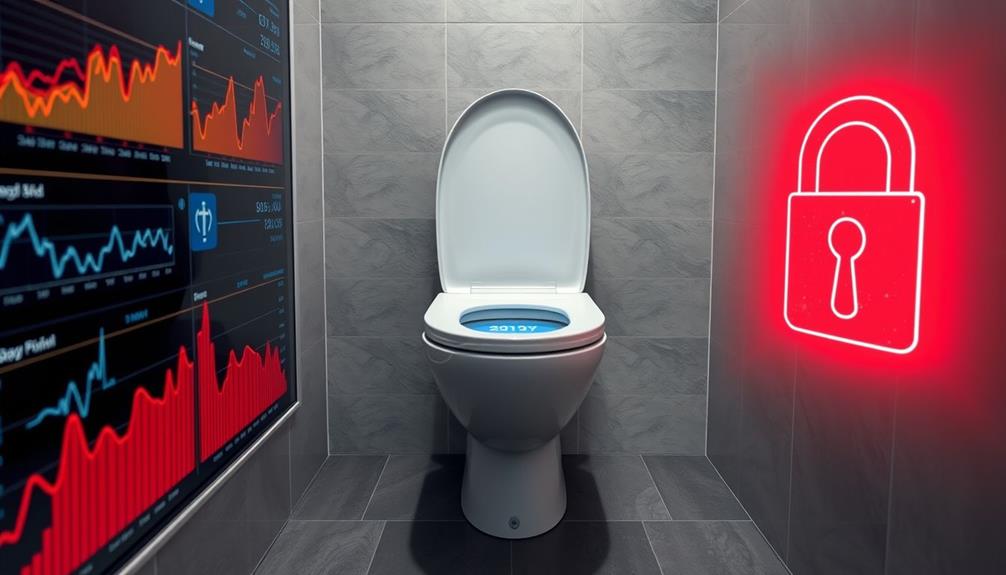
Experts frequently engage in heated discussions about smart toilets, highlighting a spectrum of opinions on their ethical implications. Some, like Renée Remijnse, strongly oppose using facial recognition technology in bathrooms, arguing it infringes on personal privacy and comfort.
Angelika Koppe echoes these concerns, questioning the necessity of invasive health-monitoring data collection. However, others, such as Diversey, advocate for visitor tracking in public bathrooms, suggesting that the operational benefits may outweigh privacy concerns.
The debate often centers around these key emotional points:
- Invasion of Privacy: Many fear the loss of personal space and comfort in such an intimate setting.
- Data Misuse: There's a growing anxiety about how collected data might be exploited or mishandled.
- Health Benefits: Proponents emphasize the potential for smart toilets to contribute considerably to medical research and public health.
As discussions unfold, experts remain divided on the ethics of advanced bathroom technology. Some call for stricter regulations to safeguard user data, while others emphasize the critical health advantages that smart toilets can provide.
Balancing these concerns is essential for the future of smart toilet implementation.
Future Trends in Smart Bathroom Tech
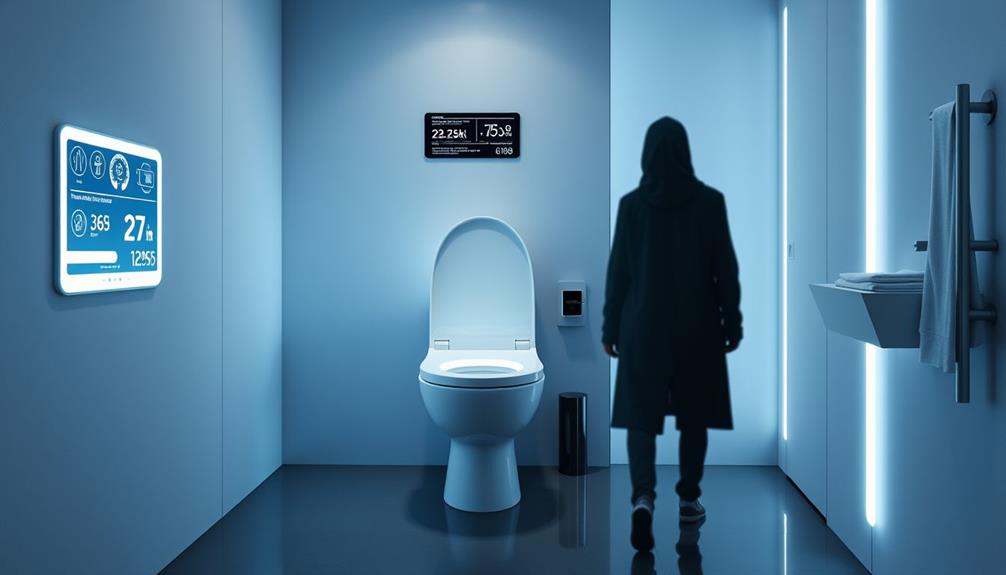
As debates about privacy and ethics continue, the future of smart bathroom technology looks promising and innovative. Imagine a world where public restrooms incorporate health monitoring systems that provide real-time data for entire populations. This evolution in smart bathroom technology is more than just convenience; it could enhance hygiene and sanitation by detecting health issues through waste analysis.
Here's a glimpse into future trends:
| Feature | Benefit | Privacy Concern |
|---|---|---|
| Health Monitoring Systems | Real-time health data collection | User consent and data security |
| Advanced Waste Analysis | Early detection of health issues | Data sharing policies |
| User-Friendly Smart Toilets | Accessible for everyone | Anonymity in data collection |
| Cost-Effective Technologies | Affordable health monitoring | Transparency in usage |
Research is also focusing on making these smart toilets cost-effective and user-friendly, with advancements in portable mass spectrometry. As cities aim to integrate smart bathroom technology into their infrastructures, the potential for improved public health outcomes becomes increasingly clear. Balancing these benefits with privacy will be essential as we move forward.
Frequently Asked Questions
What Are the Cons of Smart Toilets?
Smart toilets can invade your privacy by collecting sensitive data, potentially leading to unauthorized access. You might feel uncomfortable with their use, fearing that personal health information could be misused or shared without your consent.
How Smart Toilets Can Monitor Health?
Smart toilets monitor your health by analyzing urine for metabolites, detecting changes in flow, and identifying biomarkers. This technology provides real-time insights into your nutritional status and potential health issues, enabling proactive health management.
Are Smart Toilets Worth It?
Smart toilets can be worth it for you if you're interested in proactive health monitoring. They offer valuable insights into your metabolic health, making it easier to track changes and address potential health issues early.
Is There a Smart Toilet That Identifies Analprints?
Currently, there isn't a smart toilet specifically designed to identify analprints. While the technology is theoretically possible, it's still in development, focusing more on health monitoring rather than biometric identification, ensuring user privacy remains a priority.
Conclusion
As the debate over smart toilet data collection heats up, it's crucial to weigh the pros and cons carefully. While these innovations can enhance your health monitoring, they also raise significant privacy concerns. It's vital to find a balance that keeps your personal information safe while reaping the benefits of technology. Ultimately, staying informed and vigilant will help you navigate this evolving landscape, ensuring you don't throw the baby out with the bathwater.
With an impeccable eye for detail and a passion for bathroom-related, Ava leads our editorial team gracefully and precisely.
Under her guidance, Best Modern Toilet has flourished as the go-to resource for modern bathroom enthusiasts. In her free time, you might find Ava exploring antique shops and looking for vintage bathroom fixtures to add to her collection.
Guides
Smart Toilets in Hotels: Enhancing the Guest Experience
Plunge into the future of hospitality with smart toilets that elevate your comfort and hygiene—discover the innovative features transforming guest experiences today.
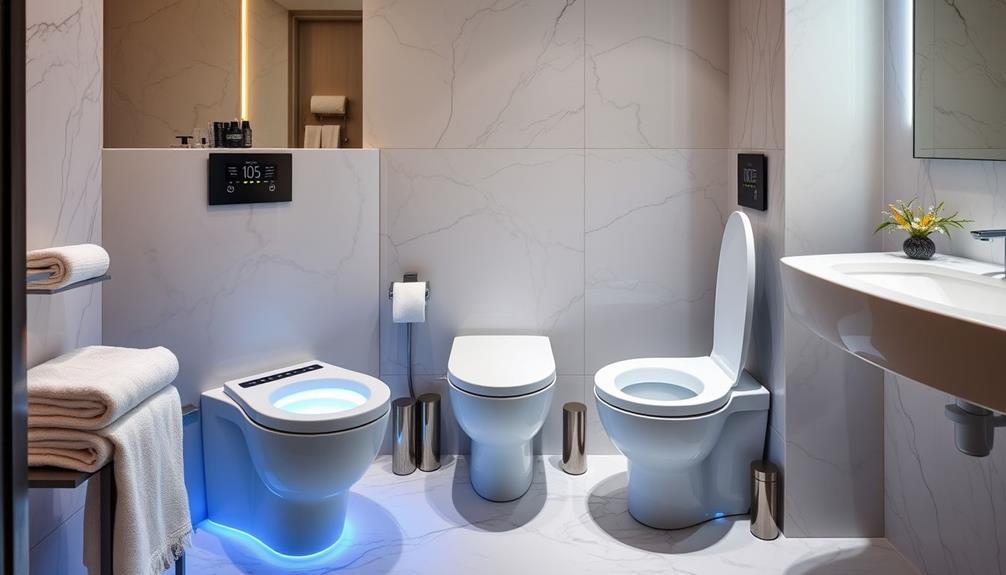
Smart toilets in hotels are changing how you experience restroom facilities, combining hygiene and personalization seamlessly. You'll appreciate features like adjustable seat temperatures, personalized cleaning settings, and self-cleaning technology that enhances sanitation. These innovations not only elevate your comfort but also reflect a hotel's commitment to modern amenities. With eco-friendly water usage and touchless controls, these toilets cater to your needs while promoting sustainability. So next time you stay, expect a more enjoyable visit with enhanced hygiene and personalized experiences. To discover more about the benefits of smart toilets, stay tuned for what's next in hotel technology.
Key Takeaways
- Smart toilets offer personalized settings, enhancing comfort and ensuring a tailored bathroom experience for each guest.
- Advanced cleaning technologies, like self-cleaning features, ensure high hygiene standards and peace of mind for guests.
- Eco-friendly water usage through dual-flush systems reduces consumption, aligning with sustainability goals and appealing to environmentally conscious travelers.
- Integration with mobile apps allows guests to pre-set their preferences, streamlining their experience and improving satisfaction.
- Touchless controls and automated maintenance alerts promote a hygienic environment while reducing downtime and maintenance costs for hotels.
Evolution of Guest Expectations
Shifting guest expectations have transformed the hotel experience, pushing high-tech features to the forefront. You've likely noticed that what once felt like luxury—like air conditioning and color TVs—has now become standard. Guests now demand more than just basic amenities; they seek innovative solutions that enhance their stay.
This evolution highlights the significance of guest satisfaction, as modern travelers expect high-tech features as part of their overall experience. The introduction of toilet types and systems that prioritize efficiency and comfort is becoming increasingly pertinent in this situation.
Smart rooms are revolutionizing the way you interact with hotel spaces, especially in the bathroom. Innovations like smart toilets, equipped with heated seats and bidet functions, cater to the growing desire for personalized and hygienic experiences.
Research shows that a staggering 88% of guests avoid businesses with unclean or outdated restroom facilities, emphasizing how vital these modern expectations are for return visits.
As hotels continue to adopt these advancements, the integration of smart technology reflects a commitment to enhancing guest comfort and addressing environmental concerns.
Key Features of Smart Toilets
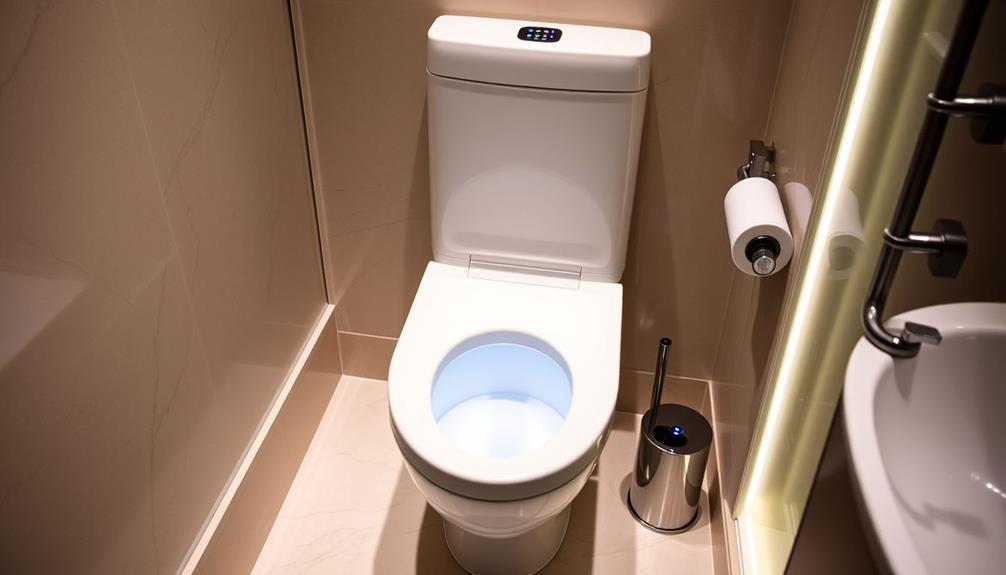
When you step into a hotel bathroom with a smart toilet, you'll immediately notice features designed for your comfort and convenience.
These toilets not only offer personalized settings for cleaning and hygiene but also promote eco-friendly water usage.
With advanced technologies, they guarantee a superior experience that aligns with modern sustainability practices.
Additionally, implementing efficient systems can enhance the overall guest experience while also contributing to credit card insights that help hotels manage transactions seamlessly.
Advanced Cleaning Technologies
Many modern hotels are embracing smart toilets that come equipped with advanced cleaning technologies, guaranteeing a hygienic experience for every guest. These innovations address your hygiene demands while enhancing the guest experience.
| Feature | Description | Benefits |
|---|---|---|
| Self-Cleaning | Utilizes UV light and disinfectants | Reduces germs and bacteria |
| Automated Flushing | Flushing based on user presence | Conserves water, enhances hygiene |
| Integrated Bidet | Customizable washing settings | Promotes personal hygiene |
With features like self-cleaning capabilities, smart toilets considerably cut down the risk of contamination. Automated flushing mechanisms not only help maintain cleanliness but also save water, aligning with eco-friendly practices. The integrated bidet, complete with adjustable temperature and water pressure, guarantees your comfort and hygiene needs are met.
Additionally, advanced sensors monitor usage patterns, allowing for proactive maintenance. This means you're less likely to face empty toilet paper rolls or inadequate cleaning supplies. Some models even include air-drying features, providing a touchless alternative to traditional toilet paper, further supporting sustainability efforts in hotel operations.
Personalized User Preferences
Smart toilets are designed to cater specifically to your preferences, creating a tailored experience that enhances both comfort and hygiene.
These innovative fixtures can remember your personalized user preferences, allowing you to enjoy features like adjustable seat temperature, bidet settings, and flushing options. Imagine stepping into a hotel bathroom where everything is already set just the way you like it.
Additionally, the efficiency of these smart devices can be compared to modern heating technologies, such as thermal energy transfer, which optimize performance and user satisfaction.
Many smart toilets offer adjustable water pressure and temperature for bidet functions, ensuring a customized hygiene experience that meets your unique needs.
Some models even allow you to access user profiles through mobile apps. This means you can pre-set your toilet settings before you even enter the bathroom, making your stay even more enjoyable.
Additionally, smart toilets often come equipped with automatic cleaning features, which means your preferences for cleanliness are consistently met without any manual effort.
This integration of smart technology not only elevates your comfort but also considerably contributes to enhancing the guest experience.
Studies show that a remarkable 88% of guests are likely to return to hotels that prioritize modern amenities and cleanliness, making smart toilets a smart choice for any establishment.
Eco-Friendly Water Usage
Eco-friendly water usage is a standout feature of modern smart toilets, aligning convenience with sustainability. By choosing a smart toilet during your hotel stay, you contribute to eco-friendly practices that notably reduce water consumption.
These toilets often come equipped with dual-flush systems, allowing you to select between a low-volume flush for liquid waste and a higher volume for solid waste. This can cut water usage by up to 30% compared to traditional models. Additionally, many smart toilets incorporate features such as advanced air purification options that enhance the overall hygiene of the restroom environment.
Moreover, smart toilets utilize sensors to detect usage patterns, automatically adjusting water flow for maximum efficiency. Other features, like integrated bidet functions, not only minimize the need for toilet paper but also decrease the water used in its production and disposal.
Here are some key aspects of eco-friendly water usage in smart toilets:
- Aerated flush systems that mix air with water, using less without sacrificing performance.
- Advanced materials and designs that reduce waste buildup, cutting down on cleaning-related water usage.
- Automatic adjustments to optimize water flow based on actual needs.
With these innovations, smart toilets help promote sustainability while enhancing your guest experience.
Impact on Guest Satisfaction
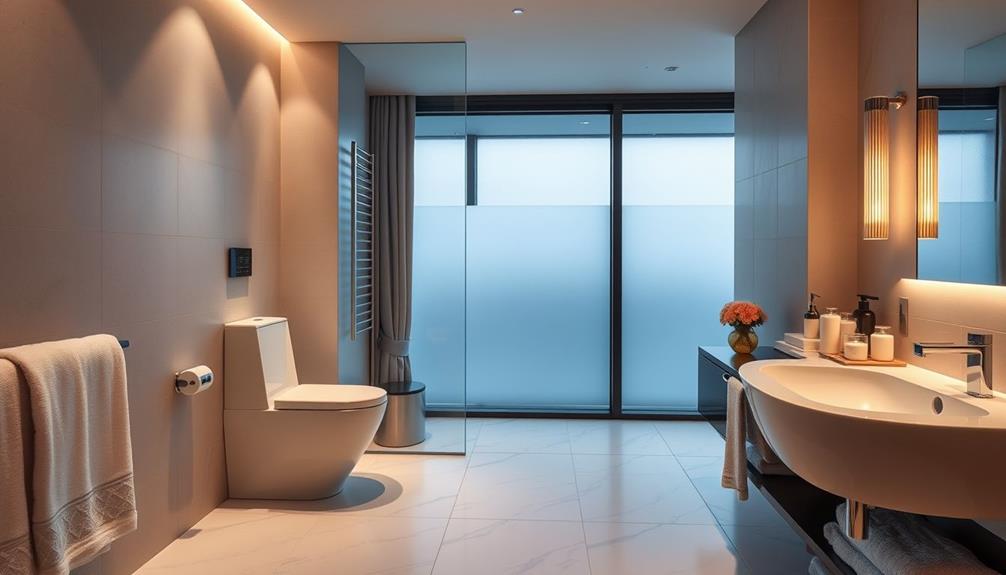
When you use a smart toilet in a hotel, you'll notice how its innovative hygiene features elevate your comfort and peace of mind.
By incorporating stress management techniques into your stay, you can further enhance your overall well-being during your travels.
Personalizing options like water temperature makes your experience feel tailored just for you, while streamlined maintenance guarantees the restroom stays clean and welcoming.
These factors all contribute to a satisfying stay, making you more likely to return.
Innovative Hygiene Features
A growing number of hotels are embracing innovative hygiene features that greatly enhance guest satisfaction.
Smart toilets equipped with touchless technology, like automatic flushing and seat lifting, guarantee high hygiene standards, reassuring you about cleanliness in busy restroom environments. These advancements not only elevate your comfort but also promote better personal hygiene, which is essential during your stay.
Additionally, many hotels are also focusing on essential items for a home cleaning kit to guarantee that all surfaces are kept immaculate and hygienic throughout your visit.
Consider these key benefits of smart toilets:
- Integrated Bidet Functions: These promote better hygiene, making your experience more comfortable.
- Advanced Self-Cleaning Technologies: They minimize manual cleaning, guaranteeing consistent sanitation and reducing germ transmission risks.
- Heated Seats & Customizable Water Temperature: These features align with wellness trends, adding an extra layer of comfort and relaxation to your visit.
Personalized Comfort Options
Smart toilets not only enhance hygiene but also cater to personalized comfort options that greatly impact guest satisfaction. Imagine stepping into a hotel bathroom where the seat temperature and water pressure are set just the way you like them. That's what smart toilets offer—adjustable features that elevate your guest experience.
With heated seats and bidet functions, you'll find that 88% of travelers agree that clean, well-maintained restrooms considerably influence their decision to return. Additionally, maintaining a clean and comfortable environment is vital for overall mental well-being, as indicated by mental health support which is essential for cognitive health maintenance.
These toilets often come equipped with user profiles, allowing you to save your preferred settings for future visits. This means you won't have to adjust anything again; it's all set up just for you.
Plus, the integration of touchless controls and self-cleaning functions not only enhances comfort but also guarantees a hygienic environment, addressing any concerns you might have.
Streamlined Maintenance Efficiency
With the integration of cutting-edge technology in hotel restrooms, streamlined maintenance efficiency becomes a game-changer for guest satisfaction.
Smart toilets equipped with sensors offer real-time data on usage patterns, allowing hotel staff to optimize cleaning schedules and maintenance. This not only enhances restroom hygiene but also greatly reduces downtime and maintenance costs.
Additionally, just like the self-cleaning mechanisms found in self-cleaning brush rolls, these toilets simplify upkeep, guaranteeing a consistently pristine environment for guests.
Here's how smart toilets boost your guest experience:
- Automated alerts: Smart toilets notify maintenance teams about low supplies or malfunctions, minimizing wait times and complaints.
- Peak time management: Real-time insights guarantee cleanliness and adequate supplies during busy periods, creating a hassle-free environment for guests.
- Sustainability focus: These toilets monitor water usage, reducing waste and aligning with your expectations for environmentally conscious practices.
Sustainability and Environmental Benefits
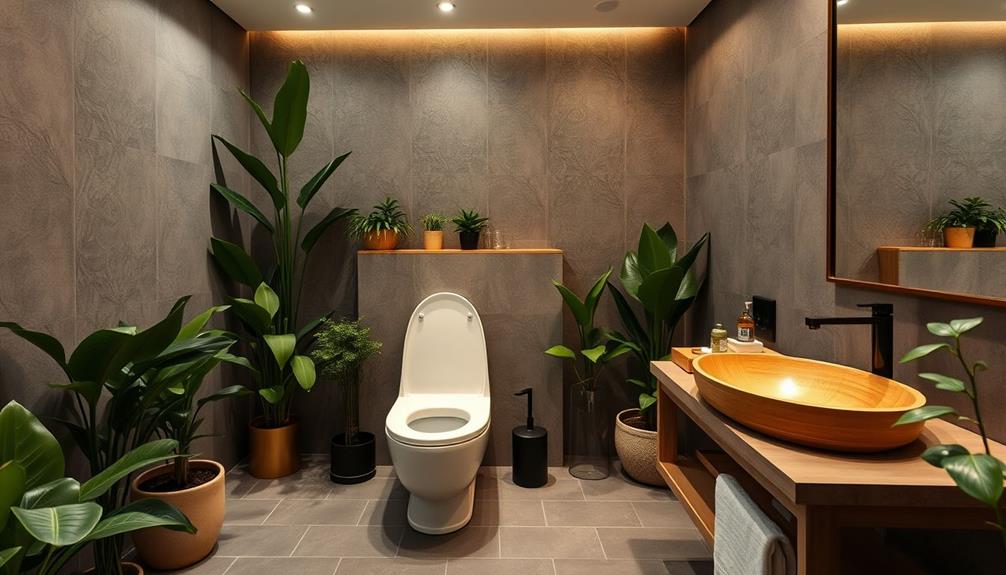
Many hotels are embracing smart toilets as a key component of their sustainability initiatives. These advanced toilets greatly reduce water consumption through optimized flushing systems, helping hotels meet their sustainability goals.
With features like dual-flush mechanisms, you can choose between a full or half flush, which further minimizes water waste while you stay. Additionally, just as Turtle Tree Seeds focuses on sustainable practices, hotels adopting smart toilets contribute to environmental conservation efforts.
Beyond conserving water, smart toilets enhance hygiene practices. Their touchless technology reduces the spread of germs, creating a healthier environment for you and other guests. This focus on hygiene is especially important in today's world, where cleanliness is paramount.
Additionally, smart toilets are designed with energy efficiency in mind. They lower electricity consumption associated with water heating and other functionalities, aligning perfectly with hotels' sustainability initiatives.
By incorporating these innovative toilets, hotels can also reduce operational costs, ultimately leading to enhanced environmental efficiency and long-term financial sustainability.
When you choose to stay in a hotel with smart toilets, you're not just enjoying modern conveniences; you're also supporting a commitment to sustainability and a healthier experience for everyone.
Integration Challenges and Solutions

Hotels face various integration challenges when adopting smart toilets, particularly concerning compatibility with existing plumbing and electrical systems. Retrofitting can lead to significant costs, so it's crucial to weigh these against the potential benefits.
For instance, just as with the conversion of retirement accounts, conducting a thorough analysis of costs versus benefits is essential, as it helps in identifying long-term advantages such as diversification of retirement portfolio that can lead to increased guest satisfaction and retention.
To guarantee a smooth changeover, consider these solutions:
- Conduct thorough cost-benefit analyses: Evaluate the long-term financial impacts, factoring in increased guest satisfaction and retention.
- Implement user-friendly interfaces: Make it easy for guests to use smart toilets, minimizing the need for extensive staff training and guaranteeing a positive guest experience.
- Address data privacy concerns: Establish transparent policies and secure data management practices to protect user information collected by smart toilets.
Additionally, having ongoing maintenance and technical support plans is critical. This way, you can promptly address any issues that arise, preventing disruptions that could negatively impact the guest experience.
Future Trends in Hotel Technology
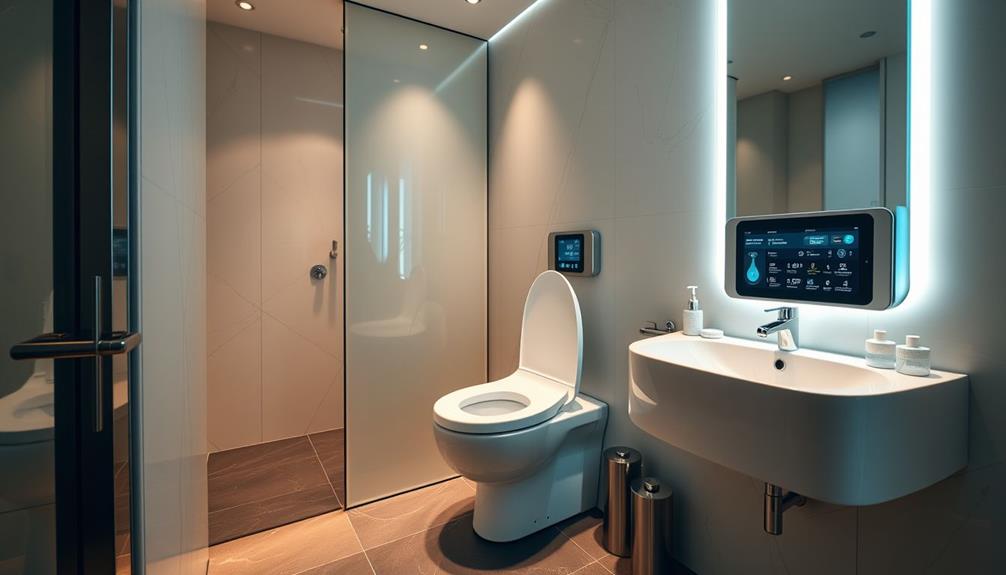
As technology continues to evolve, the hospitality industry is embracing innovative solutions to enhance guest experiences. One of the most exciting trends is the integration of smart toilets in hotels. These high-tech fixtures not only provide comfort with features like heated seats and automatic lids, but they also cater to the eco-conscious traveler with water-saving flush systems and self-cleaning capabilities.
Here's a quick overview of how smart toilets are shaping the future of hotel technology:
| Feature | Benefit |
|---|---|
| Real-time Analytics | Optimize maintenance |
| Personalized Settings | Tailored guest experience |
| Sustainability Focus | Promote hygiene and eco-friendliness |
| Luxury Convenience | Meet tech-savvy traveler expectations |
As the demand for luxury and convenience rises, expect to see more hotels adopting these smart toilets. They'll not only enhance your stay but also help hotels reduce operational costs. Embracing these advancements aligns with broader trends in hotel technology, ensuring you have the best guest experience possible.
Frequently Asked Questions
How Does Technology Help Improve Hotel Guest Experience?
Technology improves your hotel experience by offering personalized services, seamless check-ins, smart room controls, and enhanced connectivity. You get convenience and comfort, making your stay more enjoyable and tailored to your preferences.
What Is the Impact of Technology Amenities on Hotel Guest Overall Satisfaction?
Technology amenities greatly boost your overall satisfaction in hotels. You enjoy enhanced comfort, convenience, and hygiene, leading to a more enjoyable stay. With personalized features, you're likely to feel valued and more inclined to return.
How Can Hotels Increase Guest Satisfaction?
To increase guest satisfaction, focus on personalized experiences, maintain exceptional cleanliness, offer modern amenities, and guarantee responsive customer service. Engaging with guests' feedback can also help you continuously improve their overall experience at your hotel.
What Is the Role of Technology in Personalized Guest Experience?
Technology plays an essential role in personalizing your experience. It gathers data on your preferences, allowing for tailored services, instant communication, and seamless interactions that elevate your stay and cater to your individual needs and desires.
Conclusion
Incorporating smart toilets in hotels not only meets evolving guest expectations but also elevates the overall experience. With 69% of travelers expressing interest in smart technology, it's clear that these innovative features resonate with modern consumers. By enhancing comfort and convenience, hotels can greatly boost guest satisfaction. As the industry embraces sustainability and navigates integration challenges, smart toilets stand out as a forward-thinking solution that can redefine hospitality for a greener, more connected future.
With an impeccable eye for detail and a passion for bathroom-related, Ava leads our editorial team gracefully and precisely.
Under her guidance, Best Modern Toilet has flourished as the go-to resource for modern bathroom enthusiasts. In her free time, you might find Ava exploring antique shops and looking for vintage bathroom fixtures to add to her collection.
-

 Bathtub2 months ago
Bathtub2 months agoAre Clorox Toilet Wand Refills Septic Safe
-

 Reviews3 months ago
Reviews3 months agoLoupusuo Luxury Smart Toilet Review [2024]
-

 Reviews3 months ago
Reviews3 months agoSimple Project Modern Smart Toilet Review [2024]
-

 FAQ - Advanced Bathroom Queries2 months ago
FAQ - Advanced Bathroom Queries2 months agoWhat to Do if You Accidentally Flush a Paper Towel
-

 Reviews3 months ago
Reviews3 months agoLDian Smart Toilet Review: Luxury and Hygiene Combined [2024]
-

 Toilet Brands2 months ago
Toilet Brands2 months agoCan You Put Toilet Paper Down the Toilet in Cyprus
-

 Reviews2 months ago
Reviews2 months agoWhich Is Better Flush Valve or Flush Tank
-

 FAQ - Advanced Bathroom Queries2 months ago
FAQ - Advanced Bathroom Queries2 months agoWhat to Do if a Toilet Paper Roll Gets Flushed Down the Toilet























